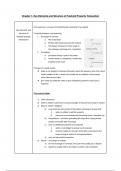Resume
Summary SQE1 Property Practice Revision Notes
- Cours
- Établissement
Summary of the ULaw property practice textbook. Covers every detail required to memorise from the textbook for SQE assessment. Saves you time from reading the whole textbook which includes information that is not targeting the exam.
[Montrer plus]



